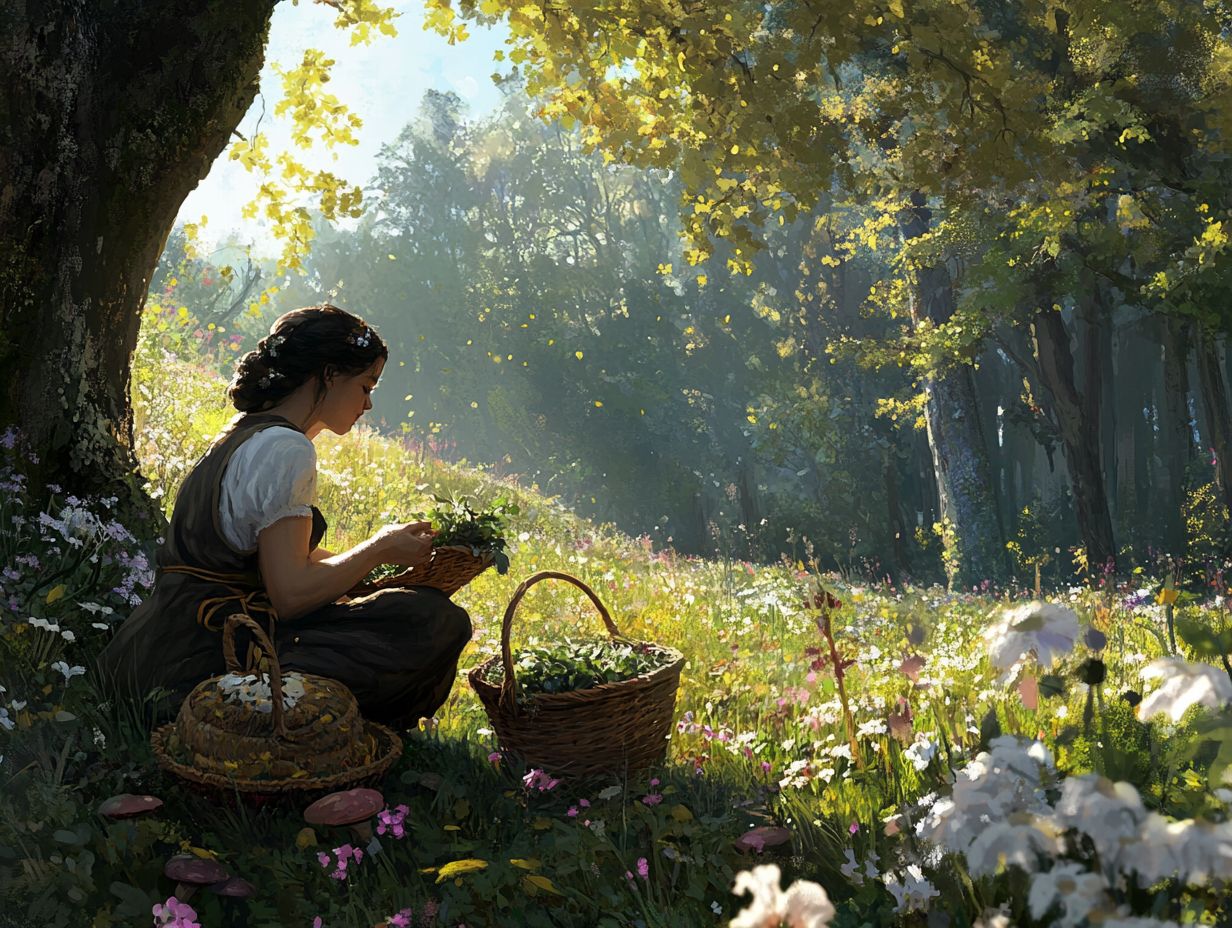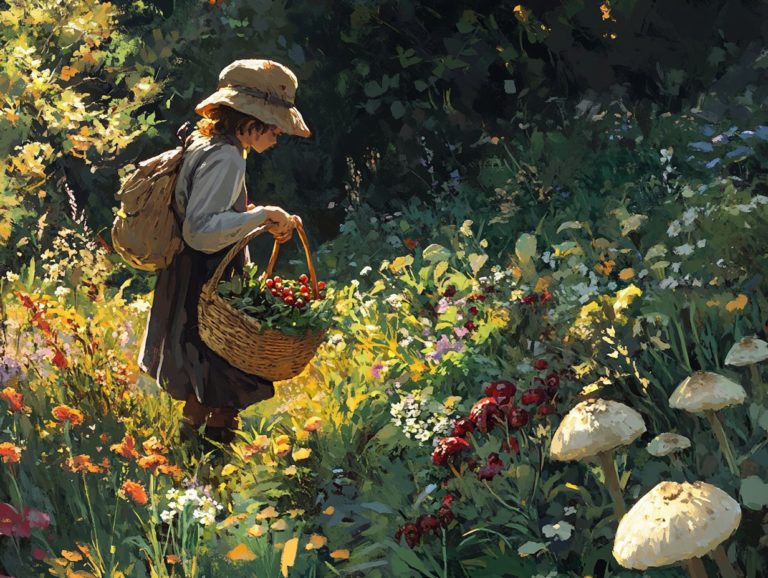The Healing Power of Foraging Techniques
Foraging transcends mere trend; it s an immersive journey into the wild that forges a deep connection between you, nature, and your food.
This article delves into the myriad benefits of foraging, highlighting the nutritional and medicinal treasures found in wild plants while championing a sustainable lifestyle. You ll acquire essential techniques for identifying and harvesting edible plants, along with crucial safety tips to safeguard both yourself and the environment.
Whether you re a seasoned forager or simply curious about the natural bounty that surrounds you, there s a wealth of knowledge awaiting you in this exploration.
Contents
- Key Takeaways:
- The Benefits of Foraging
- Foraging Techniques
- Foraging Safety and Precautions
- Foraging for Beginners
- Frequently Asked Questions
- What are foraging techniques and how do they promote healing?
- What are some common foraging techniques used for healing?
- Can foraging techniques be dangerous or harmful?
- What are the potential health benefits of foraging techniques?
- Are there any cultural or spiritual aspects to foraging techniques?
- Can foraging techniques be practiced in urban areas?
Key Takeaways:

- Foraging gives you access to nutritious wild plants and helps you feel closer to nature.
- Learning how to identify and prepare these plants is essential for safe foraging.
- If you’re new to foraging, connect with experienced foragers to kickstart your adventure!
What is Foraging?
Foraging is the art of harvesting wild plants and mushrooms for food, medicine, and various uses. It allows you to reconnect with nature while promoting food security, which means having reliable access to enough nutritious food. You can explore urban foraging in your local environment or try backyard foraging, where you might discover wild edibles like dandelion, nettle, and clover.
This age-old practice harks back to our ancient ancestors, who thrived on nature’s bounty. It s experiencing a resurgence as a sustainable method to enhance community health and foster environmental awareness.
In the world of foraging, you can delve into pursuits such as mushroom foraging, berry picking, and harvesting sea vegetables. Each requires unique skills to ensure safe and proper identification, steering clear of toxic plants.
Historically, foraging has been fundamental to human survival, laying the groundwork for agriculture and shaping dietary practices worldwide. In today’s climate, as individuals increasingly seek connections to their local environments and sustainable food sources, foraging offers a chance to engage with the landscape and nurtures an appreciation for biodiversity.
Biodiversity means the variety of life in the world, which is crucial for healthy ecosystems. This makes foraging an essential practice within modern food systems.
The Benefits of Foraging
Foraging opens up a world of benefits! It enriches both personal well-being and community health by enhancing food security through access to wild edibles and the nutritional richness of various plants.
When you engage in urban foraging or explore your backyard, you not only connect with your local environment but also discover new cooking ideas with freshly harvested ingredients. Foraging improves health through herbal remedies and fosters a sense of community reliance on local resources, serving as a vital cornerstone of sustainable living.
Nutritional and Medicinal Value of Wild Plants
Wild plants like dandelion, nettle, and burdock aren t just culinary delights; they re also bursting with nutritional value and medicinal properties. This makes them essential for anyone interested in herbal medicine.
These powerful herbs provide a treasure trove of vitamins, minerals, and antioxidants that can enhance your overall health. For example, dandelion is well-known for supporting liver function and promoting detoxification. Nettle is celebrated for its anti-inflammatory benefits and high iron content. Burdock root, a staple in traditional remedies, is a fiber powerhouse that can aid digestion and improve skin health.
By exploring the science behind these plants and their rich historical usage, you can savor their unique flavors and recognize their roles as potent herbal remedies for various ailments. This knowledge opens the door to a more holistic approach to wellness, enriching your journey toward health.
Connection to Nature and Sustainable Living
Foraging for food allows you to forge a deep connection with nature while embracing sustainable living practices. It encourages you to respect and understand the cycles of the natural world. Engaging in foraging whether in urban landscapes or serene natural settings heightens your awareness of the local environment. It underscores the importance of sustainable gathering methods that bolster community health and food systems. This connection not only nurtures your personal growth but also instills a sense of responsibility toward the environment!
As you immerse yourself in the art of foraging, you begin to appreciate the delicate balance within ecosystems. Each species plays a pivotal role in sustaining community wellness. This practice transcends mere personal nourishment; it also nurtures social bonds, as foragers often share their experiences and knowledge. This cultivates a collective understanding of local biodiversity and resource management.
By emphasizing ethical foraging practices, you ensure that communities can thrive without exhausting their natural resources. This ultimately promotes resilience and fosters a deeper stewardship of the land.
Foraging Techniques

Mastering foraging techniques is crucial for elevating your foraging experience. This involves honing your skills in plant identification, safe harvesting practices, and food preparation.
Whether you re discovering edible weeds in your own backyard or gathering medicinal herbs like cleavers or mullein in your local area, grasping diverse foraging tips can truly transform your journey.
By prioritizing safety practices and deepening your understanding of wild plants, you create a rewarding connection with nature while enriching your cooking adventures.
Identifying Edible Plants
Identifying edible plants is a crucial skill for any forager. It allows you to confidently harvest wild edibles like chickweed, sheep sorrel, and delightful edible flowers. By honing your plant identification skills, you can elevate your foraging adventures and contribute meaningfully to food security within your community.
Understanding the essential differences between edible weeds and toxic plants is vital. This ensures that you practice ethical foraging, meaning only taking what you need and ensuring the plant can continue to grow, while reaping nature’s offerings.
To recognize edible plants, study their visual characteristics like leaf shape, flower color, and growth patterns. These can significantly help you distinguish between similar species. Pay attention to habitat clues, such as soil type, proximity to water sources, and the overall ecosystem. These clues can give you critical insights into which plants are likely safe to consume.
As a beginner, consult reliable field guides or use apps designed for plant identification. These resources often come equipped with pictures and descriptions that simplify the learning process. Joining local foraging groups can also provide a supportive community, enhancing your skills through shared experiences and knowledge.
Harvesting and Preparing Wild Foods
Harvesting and preparing wild foods opens the door to a world of cooking methods that enhance your dining experiences. They also maximize the nutritional and medicinal benefits of foraged ingredients.
Embarking on this foraging journey connects you deeply with nature and fosters a greater appreciation for sustainable food sources. For culinary herbs, methods like drying or infusing oils can significantly elevate flavors, transforming your dishes into something extraordinary.
For those eager to preserve wild plants, techniques such as canning, freezing, or crafting jams and jellies allow you to extend the enjoyment of seasonal flavors well beyond their peak. By incorporating diverse wild greens into your daily meals be it in salads or smoothies you can enjoy a rich array of nutrients that nature offers.
Mastering the safe identification and preparation of these natural treasures gives you the power to create memorable dishes that truly celebrate the bounty of the land.
So grab your basket and explore the wonders of foraging today!
Foraging Safety and Precautions
Foraging safety and precautions are essential for anyone keen on harvesting wild food. Understanding how to avoid poisonous plants and recognizing the environmental impacts of your foraging activities ensures a safe and pleasurable experience. Whether you’re exploring urban foraging spots or the great outdoors, it’s vital to adhere to ethical guidelines that safeguard local ecosystems.
Prioritizing safety isn t just important for your health; it s also about preserving nature’s resources for generations to come.
Avoiding Poisonous Plants
Avoiding poisonous plants is crucial for safe foraging. You need to hone your plant identification skills to differentiate between safe wild edibles and their toxic counterparts. This knowledge gives you the power to protect your health as you explore both urban landscapes and natural environments.
One effective strategy is to use field guides and mobile apps that showcase local plant life, complete with detailed descriptions and images for easy comparison. Participating in local foraging workshops or guided walks led by seasoned foragers is also incredibly beneficial. These experienced individuals can provide invaluable firsthand insights into distinguishing features and ecological contexts.
Keeping a foraging journal will help you retain what you’ve learned and enhance your understanding of seasonal variations in plant appearances. Cultivating relationships with local horticultural societies can further enrich your education, opening doors to mentorship and resources that allow you to delve deeply into the fascinating world of native plants.
Protecting the Environment

Protecting nature is crucial for healthy ecosystems. By foraging ethically, you help your community and reduce your environmental impact. Understanding the importance of preserving nature’s cycles allows you to contribute positively to your surroundings, fostering a greater appreciation for the wild food systems around you.
As you become more aware of your role in the ecosystem, you can adopt strategies that involve harvesting only what you truly need. This ensures that populations of wild plants and fungi remain strong and vibrant. Educating yourself about local flora and fauna will help you identify which species are abundant and sustainable for picking, reducing the risk of overharvesting.
It s also crucial to respect the seasons. For instance, waiting until certain berries are ripe guarantees the best quality while supporting sustainability. By being mindful of these principles, you enjoy the rewards of nature s bounty and cultivate a deeper respect for the intricate web of life that sustains these precious resources.
Foraging for Beginners
Ready to dive into the world of foraging? Foraging for beginners invites you on an exhilarating journey into the realm of wild edibles. It provides a chance to master essential skills while reveling in nature’s wonders alongside family and friends.
Involving children in foraging activities enriches their understanding of local history and edible plants while nurturing a deep appreciation for the outdoors. Equipped with the right tips and resources, you can embark on a fulfilling foraging adventure that enhances your connection to the local environment.
Don t miss out on the chance to explore wild edibles! Grab your basket, gather your friends, and let s hit the trails for a delightful foraging experience!
Tips and Resources for Getting Started
Foraging is an exciting adventure. Practical tips and reliable resources can boost your skills and confidence in identifying safe-to-eat plants.
Knowing where to look and what to gather is essential. Comprehensive field guides dedicated to your local flora can elevate your foraging experience.
Websites like Eat the Weeds offer treasure troves of information. They provide detailed articles and videos showcasing safe harvesting practices and help you identify edible plants easily.
Join local foraging workshops or wild food walks! You ll gain hands-on training and connect with experienced mentors to guide you on your journey.
Engaging with local community groups, whether online or in-person, fosters valuable discussions about seasonal availability and preparation methods. This enables you to integrate your newfound skills into everyday life while deepening your appreciation for nature’s wonders.
Frequently Asked Questions
What are foraging techniques and how do they promote healing?
Foraging techniques involve gathering and utilizing plants, herbs, and natural resources for medicinal or therapeutic purposes. This practice is based on the belief that nature provides us with remedies to enhance healing and well-being, as explored in the joy of foraging.
What are some common foraging techniques used for healing?

Common foraging techniques for healing include identifying and harvesting wild edible plants, making herbal teas and tinctures, and using foraging techniques to connect with nature for ailments like stomach issues, headaches, and skin problems.
Can foraging techniques be dangerous or harmful?
While foraging can be beneficial, having proper knowledge and training before consuming wild plants is crucial. Some plants can be toxic, so correct identification and preparation are essential.
What are the potential health benefits of foraging techniques?
Foraging can provide numerous health benefits, including increased nutrient intake, improved immune function, and reduced stress and anxiety. Many wild plants also have anti-inflammatory and antioxidant properties that can prevent and treat various diseases.
Are there any cultural or spiritual aspects to foraging techniques?
In many cultures, foraging techniques have deep roots in traditional healing practices and are intertwined with spiritual beliefs. Some foragers feel that connecting with nature through foraging enhances mental and emotional well-being, as explored in the spiritual aspects of foraging techniques.
Can foraging techniques be practiced in urban areas?
Yes, foraging techniques can be practiced in both rural and urban settings. Many cities feature community gardens or natural areas where wild plants can be harvested. It s important to research and adhere to any rules or regulations regarding foraging in these locations.






